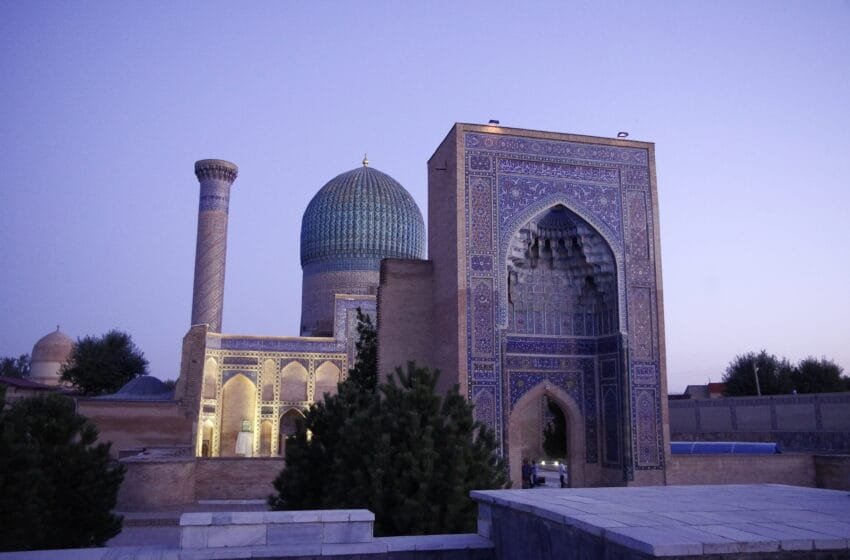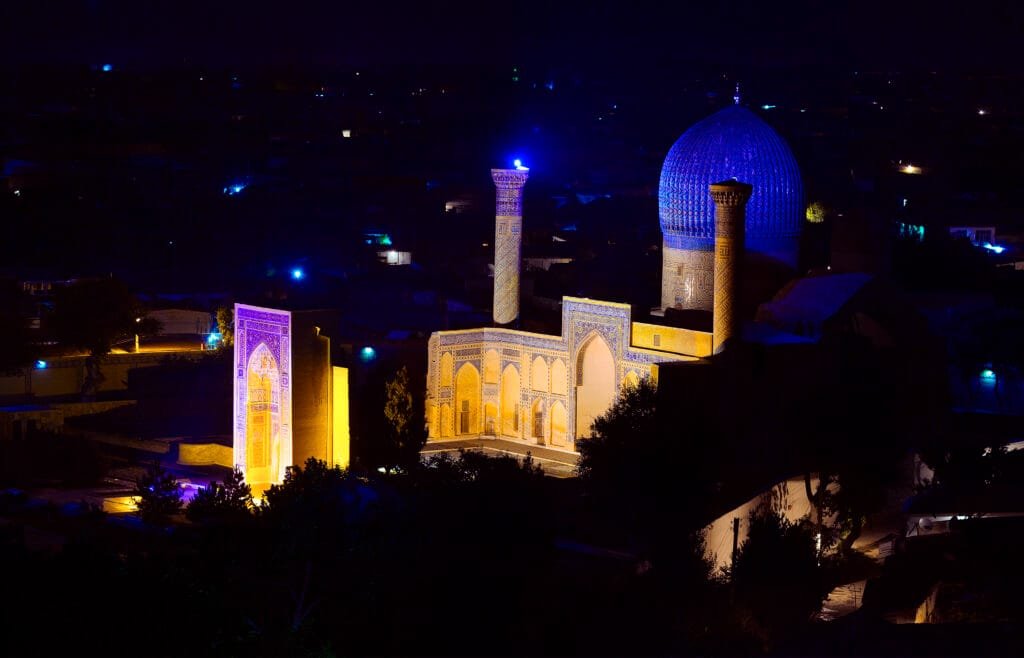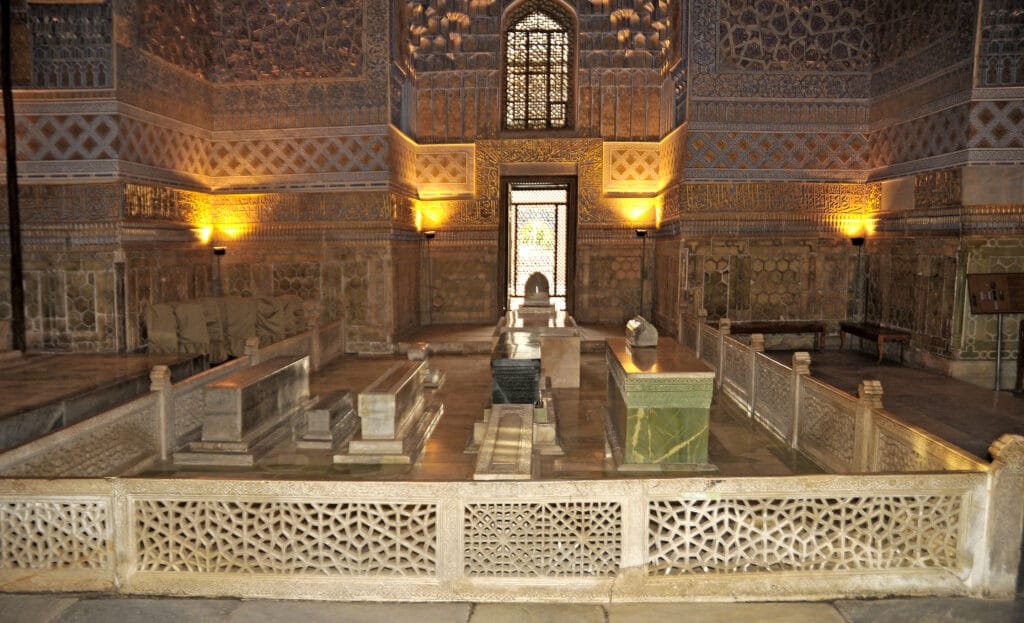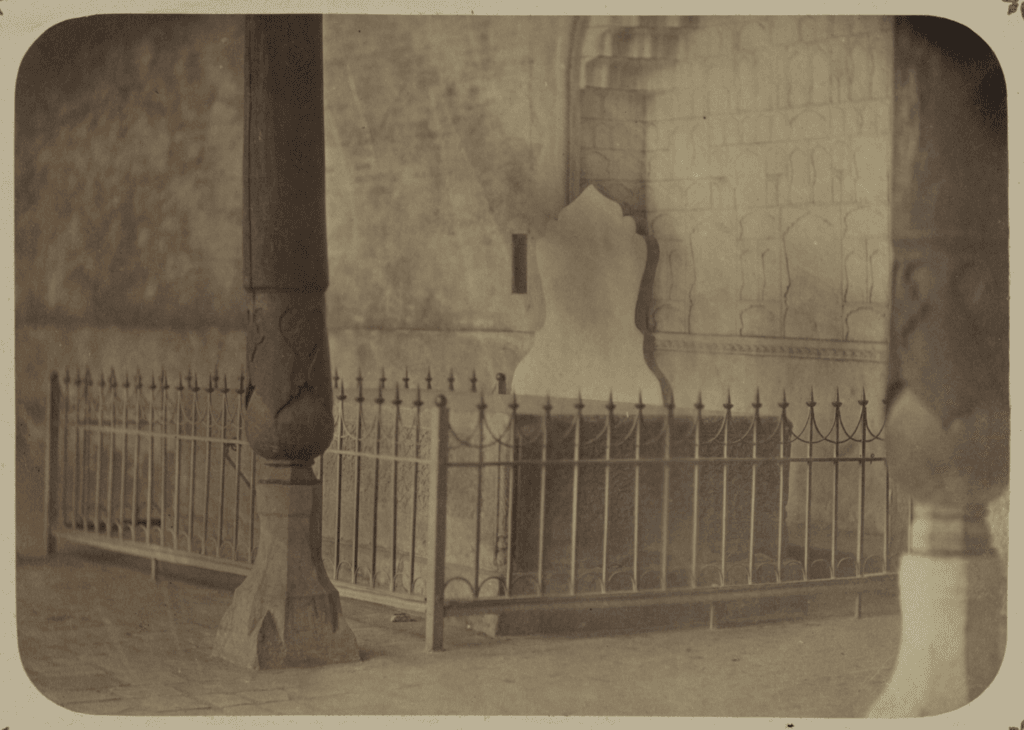Gur-e-Amir: The 15th-Century Tomb of Amir Timur with 6 Burials

Gur-e-Amir: The Tomb of Amir Timur
Gur-e-Amir stands as a monumental symbol of the Timurid dynasty, reflecting the architectural grandeur and cultural legacy of Amir Timur’s era. Originally built in the early 15th century, this masterpiece represents a significant period in the history of Central Asia, showcasing a blend of Persian, Mongol, and Central Asian architectural traditions. The mausoleum was commissioned by Timur as a memorial for his grandson, Muhammad Sultan, but later became Timur’s own burial site.
History of Gur-e-Amir: A Timeless Mausoleum
Construction and Inception
The construction of Gur-e-Amir, a masterpiece of Timurid architecture, was initiated in 1404 by the command of Timur (Tamerlane) to commemorate his grandson Muhammad Sultan, the heir to his empire who had passed away in 1403. The mausoleum is located in the southeastern part of medieval Samarkand, near Muhammad Sultan’s madrasa and khanqah. The architect responsible for its design was Mahmud Isfahani, a renowned builder from Isfahan, Iran. The structure reflects the Persian Azeri architectural style, which became a hallmark of the Timurid era.
Timur, who passed away in February 1405 during his campaign in China, was entombed here despite his wishes to be buried in his hometown of Shahrisabz. His grandson Khalil Sultan decided to inter him in this mausoleum. Gur-e-Amir later became the family mausoleum of the Timurid dynasty.

Influence on Architecture
The design of Gur-e-Amir inspired later Mughal architectural masterpieces, including Humayun’s Tomb in Delhi and the iconic Taj Mahal in Agra. These Mughal structures, created by Timur’s descendants, echo the grandeur and symmetry of this mausoleum.
The Tombs Within
Timur and His Descendants
Gur-e-Amir houses the tombs of Timur, his sons Shah Rukh and Miran Shah, his grandsons Ulugh Beg and Muhammad Sultan, and other members of the Timurid dynasty. Additionally, the tomb of Mir Sayyid Baraka, Timur’s spiritual guide, rests here.
Timur’s green nephrite cenotaph, positioned in the center of the mausoleum, is a symbol of power and sanctity. This stone was brought by Ulugh Beg as a trophy from his campaigns. The actual remains of Timur lie beneath the cenotaph in a simple crypt, accessed via a staircase leading below the mausoleum floor.
Other Graves
The mausoleum also holds the remains of other prominent figures, including descendants of Prophet Muhammad. A mysterious grave within the mausoleum is believed to belong to Sayid Umar, a descendant of the Prophet, although some scholars suggest it might be Shaykh al-Din Kulal, another revered figure.
Architectural Features
Exterior
The exterior of Gur-e-Amir is a marvel of Timurid artistry, showcasing intricate tile work, geometric patterns, and calligraphic inscriptions. The dome, covered in ribbed turquoise tiles, is one of its most iconic features, embodying the celestial aspirations of the Timurid dynasty.
Interior
The interior is richly adorned with mosaics, gilded stalactites (muqarnas), and intricate calligraphy. The lavish decoration reflects Timur’s vision of eternal splendor and the era’s architectural sophistication.
Crypt
The crypt beneath the mausoleum is simple yet solemn, constructed with rough brickwork. It houses seven flat marble gravestones corresponding to the cenotaphs above.

Architecture of Gur-e-Amir
Exterior
Gur-e-Amir is a majestic structure known for its simplicity and monumental design. The mausoleum is a domed edifice with an underground crypt, reflecting the Timurid architectural style and Persian influences.
- Dome and Structure
- The ribbed dome dominates the skyline, with a diameter of 15 meters and a height of 12.5 meters. It sits atop a cylindrical drum, making up over half the total height of the building.
- The lower portion of the structure is an octagonal base, partially obscured by later additions. A modest portal on the northern side provides access to the mausoleum.
- Tilework and Ornamentation
- The exterior is adorned with striking mosaics crafted from square and elongated glazed tiles in dark blue, turquoise, and white. The ribs of the dome and the transitional stalactite patterns leading to the drum are entirely clad in these tiles.
- The drum features intricate geometric and epigraphic patterns set against a background of yellow terracotta bricks, showcasing Timurid craftsmanship.
- Unique Features
- The intricate muqarnas vaults and mosaics highlight the architectural sophistication of the era.
- The portal’s tympanum features intricate geometric and floral designs, emphasizing the celestial theme prevalent in Islamic art.
Interior
The interior of Gur-e-Amir is a masterpiece of Timurid opulence, contrasting with the simpler underground crypt.
- Decoration and Materials
- Walls at the base are lined with marble panels featuring green serpentine inlays and engraved friezes. Above these, the walls are painted in shades of blue and gold.
- The ceiling mimics a starry sky with ornate gilded rosettes, enhancing the spiritual ambiance of the space.
- Features
- Decorative window screens (jali) and a marble balustrade surround the cenotaphs. These, however, serve only as symbolic markers; the actual graves lie in the crypt below.
- The inner dome showcases an elaborate kundal technique of layered painting with extensive use of gold.
- Inscriptions
- Quranic inscriptions and calligraphic verses dominate the walls, including phrases such as “Eternity belongs to God” and “Praise be to God.”
Historical Artifacts
- Removed and Recovered Items
- Several artifacts were removed from the mausoleum over time, including mosaic panels, doors, and inscriptions. Notably, a beautifully inscribed tile mosaic, removed in the early 20th century, was later recovered and is now displayed at the Hermitage Museum.
- The Throne Stone (Kuk-Tash)
- Once located in Timur’s palace, the Kuk-Tash served as the coronation throne for Timurid and subsequent rulers. It was relocated to Gur-e-Amir in the 20th century and now resides in the mausoleum’s courtyard.
Restoration and Preservation
- Historical Restorations
- Timurid and Mughal rulers periodically funded repairs, including significant contributions in the 17th century by Babur’s descendants.
- Soviet-era restorations in the 20th century stabilized the structure, repaired the dome, and reinstalled key decorative elements.
- Modern Efforts
- In 1996, as part of celebrations marking the 660th anniversary of Timur’s birth, two minarets were reconstructed based on historical photographs and drawings. The site continues to be a focal point of restoration and cultural preservation efforts in Uzbekistan.
Gur-e-Amir remains a symbol of Timurid glory, blending architectural innovation with deep cultural and historical significance.
Mausoleums of Ruhabad and Aksaray: A Historical and Cultural Overview
Overview
The Mausoleum of Ruhabad and the Mausoleum of Aksaray are two smaller but historically significant structures located near the iconic Gur-e-Amir in Samarkand. Though distinct in purpose and design, their proximity to Gur-e-Amir often leads them to be viewed as part of a collective architectural ensemble. Additionally, the now-lost Mausoleum of Qutbi-Char-dahum, dedicated to Sheikh Nuriddin Basir, once stood nearby, constructed by Amir Timur in 1371.
Historical Context
- Mausoleum of Ruhabad
- Literally translating to “Abode of the Spirit,” Ruhabad is one of Samarkand’s oldest surviving monuments. Built in the 14th century, the mausoleum is traditionally associated with Sheikh Burhaniddin Sagarji, a revered Islamic scholar.
- The structure, characterized by its simplicity, features a single-domed chamber with minimal decorative elements, reflecting an early Timurid architectural style.
- Legend claims the mausoleum houses a casket containing seven strands of the Prophet Muhammad’s hair, enhancing its significance as a sacred site.
- Mausoleum of Aksaray
- Built during the Timurid era, the Mausoleum of Aksaray showcases the intricate decorative techniques synonymous with this golden age of Central Asian architecture.
- The name “Aksaray,” meaning “White Palace,” likely refers to the gleaming tiles that once adorned the structure.
- The mausoleum was constructed to honor an unknown figure of prominence, potentially a member of the Timurid elite or an influential religious leader.
- Mausoleum of Qutbi-Char-dahum
- This mausoleum, also known as the “Hanaka of Nuriddin Basir,” was erected by Timur in 1371. It held immense cultural and religious importance before its destruction under Russian colonial rule.
- The historian V. L. Vyatkin noted its significance as both a mausoleum and a place of spiritual retreat. Unfortunately, it was demolished during the construction of a fortress by the Russians.
Architectural Features
- Ruhabad Mausoleum
- Its austere design includes a square base topped with a simple, unadorned dome.
- The walls are constructed from brick, with a plain exterior that emphasizes the spiritual rather than decorative aspects of the structure.
- Aksaray Mausoleum
- Unlike Ruhabad, Aksaray is more elaborate, with remnants of mosaic and tilework reflecting the artistic advancements of the Timurid period.
- Its architectural elements include intricate geometric patterns and inscriptions, showcasing the fusion of Persian and Central Asian styles.
Cultural and Religious Significance
- The Ruhabad and Aksaray mausoleums serve as reminders of Samarkand’s spiritual heritage and its role as a religious center in the Islamic world.
- The proximity of these mausoleums to Gur-e-Amir underscores the interconnectedness of Timurid-era architectural projects, with many sites serving as places of both worship and commemoration.
Legends and Mysteries
- Nuriddin Basir and Qutbi-Char-dahum
- The destruction of the Mausoleum of Qutbi-Char-dahum during the Russian colonial period remains a poignant reminder of the fragile nature of cultural heritage.
- Local legends still circulate about Sheikh Nuriddin Basir’s sanctity and the miraculous events associated with his life.
- The Legend of Nadir Shah
- In 1740, Persian ruler Nadir Shah allegedly looted the jade tombstone of Timur from Gur-e-Amir, further intertwining these monuments in the region’s tumultuous history.
- “The Spirit of Timur”
- A 20th-century legend suggests that the Soviet excavation of Timur’s tomb in Gur-e-Amir in June 1941 unleashed a “spirit of war,” coinciding with the Nazi invasion of the Soviet Union. The connection between the events remains a topic of debate and intrigue.

Preservation and Challenges
- While Gur-e-Amir has undergone extensive restoration, the Ruhabad and Aksaray mausoleums require greater attention to preserve their historical and architectural integrity.
- Their inclusion in broader preservation efforts highlights the need to safeguard Samarkand’s rich and layered heritage.
The Mausoleums of Ruhabad and Aksaray, along with the lost Qutbi-Char-dahum, embody the spiritual and cultural dynamism of Samarkand during the Timurid era, serving as enduring symbols of the city’s storied past.
Cultural and Historical Legacy
Gur-e-Amir not only serves as a mausoleum but also as a symbol of Samarkand’s historical importance as a cultural and political hub during the Timurid Empire. It influenced the development of Mughal architecture in India, particularly the design of the Taj Mahal.
Today, Gur-e-Amir remains a significant historical and cultural landmark, attracting scholars, historians, and tourists from around the world. Its inclusion in the list of “Pearls of the Commonwealth” highlights its enduring value as a masterpiece of architectural and historical heritage.





2 Comments
[…] Keyword Rankings: Your position on search engine results pages (SERPs) for specific keywords. […]
[…] the late 1300s, conqueror Tamerlane ordered a turquoise‑domed mausoleum for Sufi mystic Khoja Ahmed Yasawi. Its glazed tiles and […]